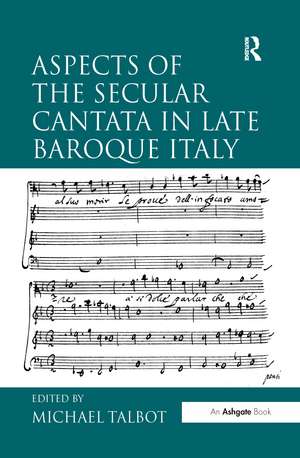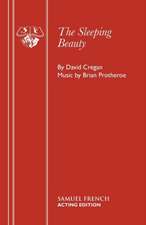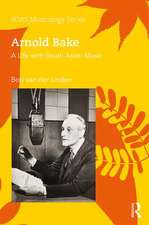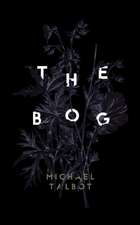Aspects of the Secular Cantata in Late Baroque Italy
Editat de Michael Talboten Limba Engleză Paperback – 28 noi 2016
| Toate formatele și edițiile | Preț | Express |
|---|---|---|
| Paperback (1) | 469.34 lei 6-8 săpt. | |
| Taylor & Francis – 28 noi 2016 | 469.34 lei 6-8 săpt. | |
| Hardback (1) | 1054.71 lei 6-8 săpt. | |
| Taylor & Francis – 28 sep 2009 | 1054.71 lei 6-8 săpt. |
Preț: 469.34 lei
Nou
Puncte Express: 704
Preț estimativ în valută:
89.81€ • 93.77$ • 74.33£
89.81€ • 93.77$ • 74.33£
Carte tipărită la comandă
Livrare economică 04-18 aprilie
Preluare comenzi: 021 569.72.76
Specificații
ISBN-13: 9781138257276
ISBN-10: 1138257273
Pagini: 452
Dimensiuni: 156 x 234 mm
Greutate: 0.45 kg
Ediția:1
Editura: Taylor & Francis
Colecția Routledge
Locul publicării:Oxford, United Kingdom
ISBN-10: 1138257273
Pagini: 452
Dimensiuni: 156 x 234 mm
Greutate: 0.45 kg
Ediția:1
Editura: Taylor & Francis
Colecția Routledge
Locul publicării:Oxford, United Kingdom
Cuprins
Contents: Preface; The when and how of Arioso in Stradella's cantatas, Carolyn Gianturco; A lost volume of cantatas and serenatas from the 'original Stradella collection', Colin Timms; Narration, mimesis and the question of genre: dramatic approaches in Giovanni Legrenzi's solo cantatas Opp 12 and 14, Hendrik Schulze; A tale of 2 cities: cantata publication in Bologna and Venice, c.1650-1700, Reinmar Emans; 'Al tavilino medesimo del compositor della musica': notes on text and context in Alessandro Scarlatti's cantate da camera, Norbert Dubowy; Bononcini's 'agreeable and easie style, and those fine inventions in his Basses (to which he was led by an instrument upon which he excels)', Lowell Lindgren; The 'humble' and 'sublime' genres, the pastoral and heroic styles: rhetorical metamorphoses in Benedetto Marcello's cantatas, Marco Bizzarini; Investigations into the cantata in Naples during the first half of the 18th century: the cantatas by Leonardo Vinci contained in a 'Neapolitan' manuscript, Giulia Veneziano; The orchestral French cantata (1706-1730): performance, edition and classification of a neglected repertory, Graham Sadler; Patterns and strategies of modulation in cantata recitatives, Michael Talbot; 'Imitando l'Arietta, ò altro allegro, cantata di fresco': keyboard realization in Italian continuo arias, Giulia Nuti; The revival of the Italian chamber cantata on disc: models and trends, Roger-Claude Travers; Bibliography; Indexes.
Notă biografică
Michael Talbot is an Emeritus Professor at the Liverpool University, UK
Recenzii
’This collection of essays by an international group of writers is much to be welcomed in contributing to scholarly studies on a relatively neglected area of academic research. ...This volume repays close attention.’ The Consort ’Focusing on the solo cantata, as conceived by Italian-born composers working between 1650 and 1750, the essays in this volume offer something for everyone, whether the reader is new to the genre, a seasoned performer, or a veteran historian... all of the essays offer important contributions to our understanding of the genre...’ Early Music America 'The volume's strength is its diversified approach, which makes it useful on various levels. ... These essays collected together by Talbot stand as a milestone in modern studies on the cantata, a further essential advance in knowledge of this repertory...' Early Music
Descriere
The contributors in this volume choose aspects of the cantata relevant to their special interests in order to say new things about the works, whether historical, analytical, bibliographical, discographical or performance-based. The prime focus is on Italian-born composers working between 1650 and 1750 and many key figures are considered, among them Tomaso Albinoni, Giovanni Bononcini, Giovanni Legrenzi, Benedetto Marcello, Alessandro Scarlatti, Alessandro Stradella, Leonardo Vinci and Antonio Vivaldi. The book aims to stimulate interest in, and to win converts to, this genre, which in its day equalled the instrumental sonata in importance, and in which more than a few composers invested a major part of their creativity.











